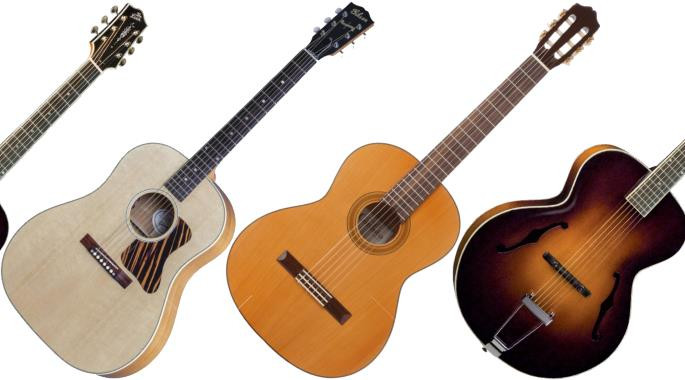 Acoustic Guitars
Acoustic Guitars
The acoustic guitar stands as a globally cherished instrument, captivating music enthusiasts across diverse genres. However, the sheer variety in acoustic guitars can be overwhelming, especially for those just beginning their musical journey. This guide aims to clarify the landscape of acoustic guitars by exploring the distinct kinds available, making your choice easier and more informed.
Understanding the Acoustic Guitar
Before we delve into the various Kinds Of Acoustic Guitar, it’s important to establish a fundamental understanding. What exactly defines an acoustic guitar?
An acoustic guitar is a stringed instrument that produces sound acoustically, meaning without electronic amplification. Sound is generated when the strings are plucked or strummed, causing them to vibrate. These vibrations resonate through the guitar’s body, which acts as a soundbox, amplifying the sound and projecting it outwards. This natural, resonant sound is a cornerstone of countless musical styles and performances.
Acoustic Guitar Types: A Comprehensive Overview
Navigating the world of acoustic guitars involves understanding the different types, each with unique sonic characteristics and playing styles. From variations in string material and body shapes to sizes and tonewoods, the options are extensive.
This article will focus on the three primary kinds of acoustic guitars, detailing their popular subtypes, defining characteristics, and typical musical applications. We will also explore the crucial role of tonewoods in shaping a guitar’s sound, providing essential knowledge for choosing the right instrument.
Steel-String Acoustic Flat Top Guitars: Versatility at its Finest
 Acoustic Guitars
Acoustic Guitars
Steel-string acoustic guitars are arguably the most prevalent kind of acoustic guitar, celebrated for their versatility and broad appeal. Their steel strings contribute to a bright, powerful sound that is well-suited for both strumming and fingerpicking techniques across a wide spectrum of musical genres. Within this category, dreadnought models are particularly popular, but any acoustic guitar employing steel strings and a hollow body is classified as a steel-string acoustic guitar.
Given the vastness of the steel-string acoustic guitar category, we will concentrate on three core body styles that represent the majority of options available: Dreadnought, OM (Orchestra Model), and Parlor. These body styles encompass the shapes you’ll most frequently encounter when exploring steel-string acoustics.
A general principle to remember is that smaller guitar bodies tend to produce warmer tones with a focused midrange, while larger bodies are typically louder and exhibit a more pronounced bass response.
When comparing guitars of similar size, the type of tonewood used becomes a more significant factor in distinguishing their sonic qualities.
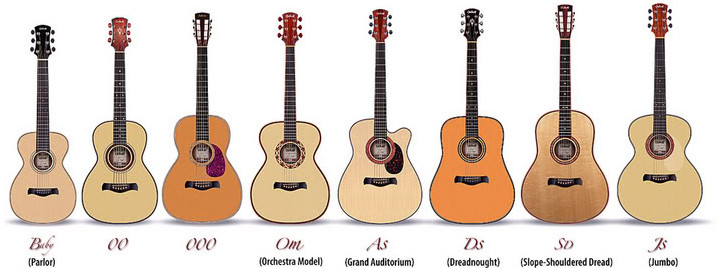 Acoustic Guitar Size Comparison Chart
Acoustic Guitar Size Comparison Chart
Dreadnought Guitars: The Iconic Acoustic Shape
Martin D-45 Square Shoulder Dreadnought Acoustic Guitar, a prime example of the square shoulder dreadnought design.
The dreadnought guitar body style is the most recognizable and widespread shape in the acoustic guitar world. For many, the dreadnought shape is synonymous with “acoustic guitar” itself. C.F. Martin & Co. pioneered this design in 1916, and it gained widespread popularity in the 1930s. In an era before sophisticated amplification, the dreadnought’s loud volume and rich tone made it ideal for ensemble performances. Today, its powerful projection and deep low-end continue to make it a favorite among guitarists.
The market is saturated with dreadnought guitars across various brands and price points, making them accessible to musicians of all levels and budgets.
Dreadnought guitars primarily come in two variations: square shoulder and slope shoulder. The square shoulder dreadnought features straighter lines in its upper and lower sections, while the slope shoulder variant has more rounded bouts in these areas.
Beyond these two main types, the dreadnought design serves as the foundation for many modern acoustic body shapes, including grand auditorium, grand concert, and jumbo guitars.
For enhanced access to the higher frets on the neck, cutaway versions of dreadnoughts and other body styles are available. Cutaways have become a standard feature, particularly on acoustic-electric guitars. While the aesthetics of cutaways can be debated, and often feature in discussions comparing electric acoustic guitars vs acoustic guitars, there is no discernible difference in acoustic sound quality between cutaway and non-cutaway dreadnoughts.
OM (Orchestra Model) Guitars: Balanced Tone and Playability
 Martin OM-28
Martin OM-28
The OM (Orchestra Model) body style occupies a middle ground in size between a dreadnought and a parlor guitar, offering a balanced sonic profile suitable for both strumming and fingerpicking. While it might not excel in either technique to the same degree as guitars specifically designed for those styles, a well-crafted OM, such as the Martin OM-28, delivers exceptional sound quality regardless of playing style. Many guitarists appreciate the OM’s clarity and defined notes, making it a favored kind of acoustic guitar for fingerstyle playing and a perfect match for singer-songwriters.
Key features of the OM body style include longer upper and lower bouts and a narrower waist compared to dreadnoughts. Numerous manufacturers produce OM-style guitars, often incorporating their own specifications and branding.
Parlor Guitars: Compact Size, Distinctive Voice
Takamine GY11ME Parlor Guitar, showcasing the compact size and classic appeal of parlor guitars.
Parlor guitars are characterized by their small body size and a focused tone that emphasizes the high-end midrange frequencies. The smaller body imparts a slightly boxy and gritty quality to the sound, particularly when played forcefully. This unique tonal character makes parlor guitars well-suited for blues, folk, rock, and similar genres. Their dimensions are also conducive to fingerstyle playing, as the smaller soundboard is easily activated, meaning it responds well to lighter playing and produces a fuller sound with less physical input. “Activating the top” refers to applying sufficient force to the guitar to vibrate the soundboard effectively, resulting in a richer, more resonant tone. A lighter touch on a parlor guitar can sometimes produce a weaker sound, so a balanced playing force is key to achieving a full representation of the bass, mid, and treble frequencies.
It’s important to note that there are no strictly defined standard specifications for parlor guitars. The term encompasses a range of traditional and modern shapes, including 0, 00, and sometimes even 000 body styles. These body styles are all relatively small and share similar sonic characteristics. Some parlor guitars also feature unique setups, from neck profiles to string action, tailored to their smaller size and intended playing styles.
For more detailed information on these smaller guitar types, resources like Parlor.Guitars offer valuable insights.
Nylon String Guitars: Warmth and Classical Tradition
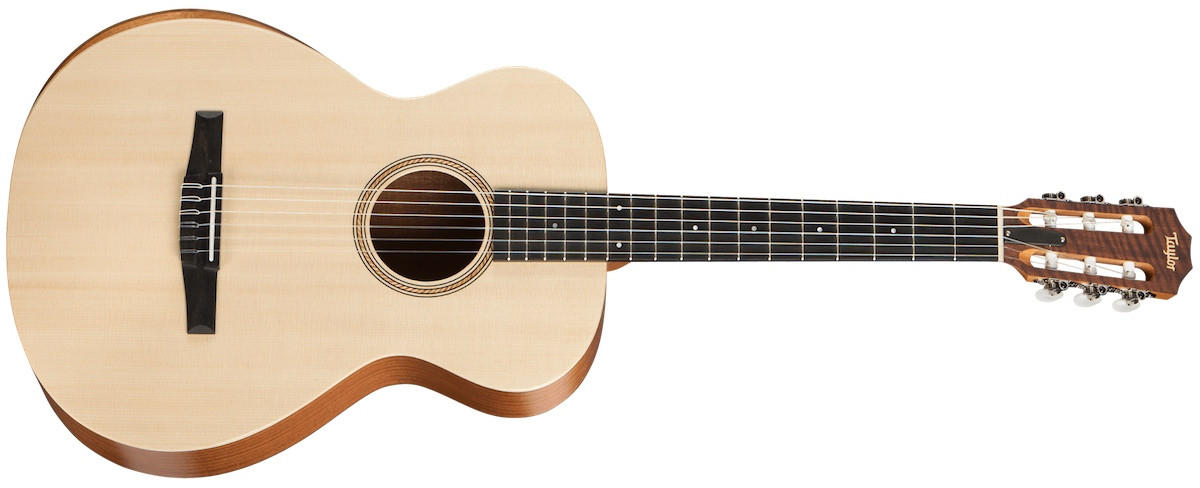 Taylor Academy 12e-N
Taylor Academy 12e-N
Nylon string guitars are often considered the most beginner-friendly kind of acoustic guitar, especially for students. The soft texture of nylon strings makes them gentler on the fingertips, ideal for beginners and younger players. Nylon strings are also the preferred choice for serious classical guitar students. Compared to steel-string guitars, nylon string guitars produce a much warmer, mellower sound. They lack the bright, ringing sustain of steel strings but offer a smooth, non-harsh tone, particularly in the upper register.
Nylon strings also have lower tension than steel strings, facilitating the execution of complex classical and flamenco techniques.
Classical guitars and Flamenco guitars are the two most prominent subtypes of nylon string guitars. The hybrid category encompasses less traditional designs, such as travel guitars, 3/4 size guitars, and silent guitars.
The three primary subcategories of nylon string guitars are:
Classical Guitars: The Sound of Tradition
Cordoba C3M Classical Guitar, a traditional classical guitar known for its clear and resonant tone.
Classical guitars are nylon-stringed instruments primarily designed for playing classical music. They are characterized by a clear, piano-like tone with ample volume and sustain. To cater to their traditional market, classical guitars largely retain their historical design, although modern manufacturing techniques and materials are now employed in their construction.
Classical guitars are generally smaller in body size than dreadnoughts but slightly wider than standard parlor guitars. Their compact size makes them well-suited for musicians with smaller frames.
In terms of size, they are closer to OM guitars but feature a different body shape. Classical guitars typically have a higher string action to accommodate various classical playing techniques. The nut width is also wider, usually around 0.2 to 0.3 inches greater than steel-string acoustic guitars. This wider neck requires fingers to stretch further when playing wide chords and passages.
Flamenco Guitars: Rhythm and Passion
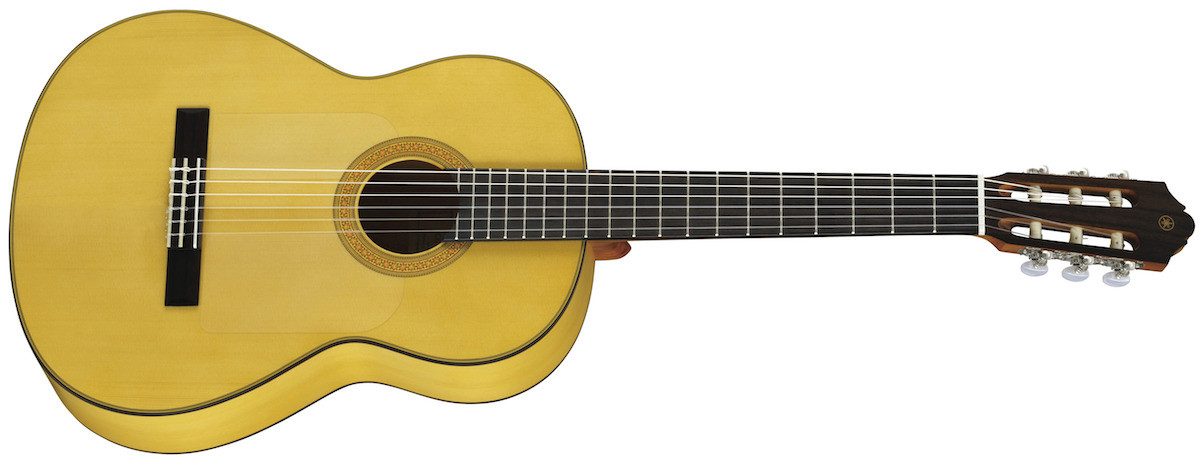 Yamaha CG172SF Flamenco
Yamaha CG172SF Flamenco
Flamenco guitars are specifically crafted for playing flamenco music. They are equipped with tap plates (also known as golpeadors) to protect the guitar’s top from the rhythmic tapping that is integral to flamenco music. Flamenco guitars generally feature low action, facilitating fast passages and percussive strumming techniques. The lower action also contributes to the characteristic growling and passionate tone associated with flamenco music when played with intensity.
Similar to classical guitars, flamenco guitars typically have a wider nut width compared to standard steel-string acoustic guitars.
Hybrid/Crossover & Other Nylon String Guitars: Expanding the Boundaries
Ibanez TOD10N Nylon String Guitar, a hybrid nylon string guitar designed for modern playing styles.
While classical and flamenco guitars represent the traditional nylon string guitar forms, non-traditional options are emerging that blend elements from different guitar types. These hybrid or crossover guitars allow players to experience the warmth of nylon strings without adhering to traditional body and neck specifications. Tim Henson’s signature acoustic-electric nylon string guitar, used in his progressive metal band Polyphia, exemplifies this trend. Other examples include mini and 3/4 size nylon string guitars designed for beginners seeking smaller, more manageable instruments.
The diversity of hybrids and crossovers across various guitar brands makes it challenging to define specific standard specifications. However, the general principles of body size and tone still apply: larger bodies tend to be louder with more bass, while smaller, thinner bodies emphasize mids and highs.
Archtop Acoustic Guitars: Jazz-Toned Elegance
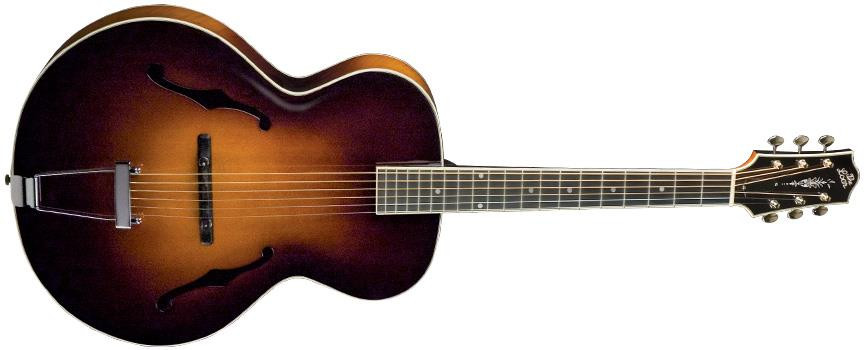 The Loar LH-700
The Loar LH-700
The defining characteristic of archtop acoustic guitars is their warm, punchy tone coupled with a distinct lack of sustain. This reduced sustain makes them particularly well-suited for intricate jazz passages and complex chord voicings. Archtops are also favored for guitar comping, a rhythmic accompaniment style central to jazz music that utilizes advanced muting, strumming, and fingerstyle techniques.
While their unique sound makes them ideal for jazz performances, archtop guitars are somewhat specialized instruments. Unless your primary musical focus is jazz (or potentially fingerstyle blues), a flat top guitar might offer greater versatility. However, for jazz enthusiasts, acoustic archtop guitars can be invaluable additions to their musical toolkit.
Archtops also tend to have bulkier bodies, which can be less portable and comfortable compared to many contemporary, sleeker acoustic guitar designs.
Other Distinct Kinds of Acoustic Guitars
Cigano GJ-15 Gypsy Jazz Guitar, highlighting the unique design and sound of Gypsy jazz guitars.
Beyond the main categories, several other noteworthy kinds of acoustic guitars deserve mention. The Gypsy jazz guitar is a specialized type dedicated to jazz music, specifically inspired by the instruments used by Django Reinhardt in Gypsy jazz. These guitars typically have larger bodies and longer necks than standard acoustics. They are distinguished by their D-shaped soundholes, although some models feature smaller oval soundholes. Gypsy guitars share sonic similarities with archtops but are generally more percussive and snappy in tone. While most Gypsy guitars use steel strings, some nylon-string models exist, blurring the lines between categories.
The 12-string acoustic guitar is another distinct type, a steel-string guitar with six pairs of strings, totaling twelve. These extra strings create a richer, fuller sound but make techniques like string bending and slides more challenging.
3/4 size acoustic guitars are miniature versions designed for children and beginners. Some manufacturers also market similar small guitars under names like “Mini” or “Junior.” It’s important to note that these smaller guitars often fall under the broader parlor guitar category.
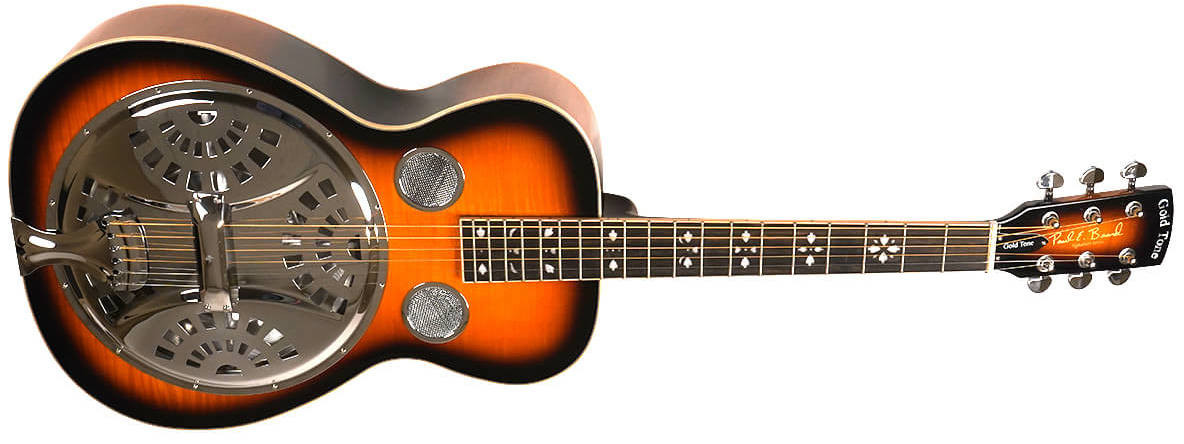 Gold Tone PBR-D Resonator Guitar
Gold Tone PBR-D Resonator Guitar
Resonator guitars utilize a metal resonator cone instead of a traditional wooden soundboard to amplify sound. This construction results in a bright, metallic, and thumpy tone, particularly well-suited for slide guitar playing and genres like bluegrass, blues, and country. For deeper exploration, resources are available to explain what is a dobro.
Traveler guitars and Silent guitars prioritize portability while aiming to retain the tonal characteristics and playing feel of regular acoustic guitars. Many traveler guitars feature skeletal bodies, resembling electric guitars in their minimalist design. Some silent guitars require amplification through an amp, PA Mixer, or headphones, but they still emulate the playing experience and sound of an acoustic instrument.
Sound Examples of Acoustic Guitar Types
Sander Briones · Dreadnought – Sound Clip
Sander Briones · OM (Orchestra Model) – Sound Clip
Sander Briones · Parlor Guitar – Sound Clip
Sander Briones · Nylon String Guitar – Sound Clip
Sander Briones · Jumbo Acoustic – Sound Clip
Acoustic vs. Classical Guitar: Key Differences
A common point of confusion, particularly for beginners, is distinguishing between acoustic and classical guitars. In essence, the primary differences lie in their strings, sound, nut width, scale length, and overall playing feel.
The most straightforward distinction is between steel-string and nylon-string guitars. Steel-string acoustic guitars are more versatile, suitable for a wide range of musical styles. Nylon-string guitars are best suited for classical, Latin, flamenco, and certain pop music styles.
Nut Width and Scale Length: Neck Dimensions Matter
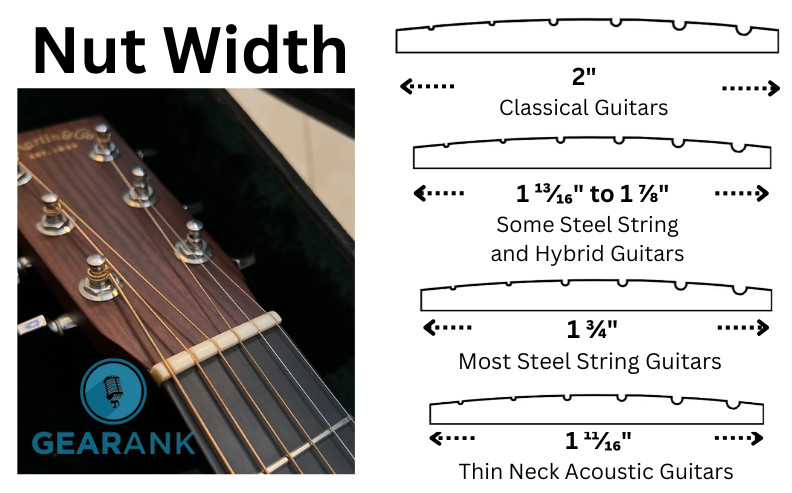 Nut Width
Nut Width
Nut width refers to the width of the guitar nut, located at the headstock end of the fretboard. As it’s positioned before the first fret, nut width is a good indicator of neck width. Narrower necks are often easier for smaller hands but can feel cramped for players with larger fingers. Wider necks provide more space between strings but can be challenging for players with shorter fingers. Classical guitars typically have the widest necks, around 2 inches, while steel-string guitars range from 1 ¹¹⁄₁₆” to 1 ⅞”.
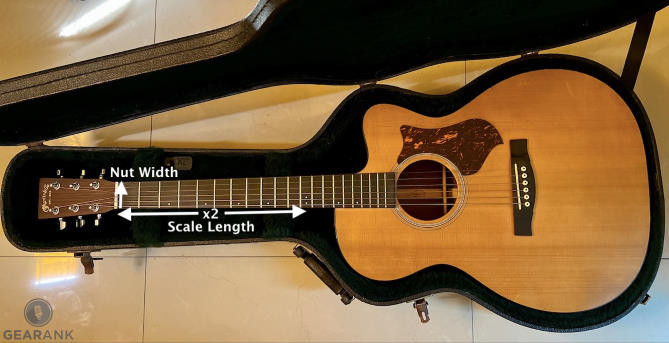 Scale Length
Scale Length
Scale length is the vibrating length of the strings, measured from the nut to the bridge. Longer scale lengths result in higher string tension, creating a stiffer feel but often enhancing resonance. Shorter scale lengths have lower string tension, making them easier to play, and can subtly influence the guitar’s tone. Most acoustic guitars have scale lengths ranging from 24.75″ to 25.6″.
Guitar Tonewoods: Shaping the Sound
The type of wood used in a guitar’s construction, known as tonewood, significantly influences its sound. While the impact of tonewoods is a subject of ongoing discussion, certain general consensus exists.
It’s crucial to remember that construction methods are as important as the tonewoods themselves. A guitar made from a particular wood will not automatically possess a specific tone; other factors are equally influential.
Most guitars utilize at least two different tonewoods, often for the top and the back/sides. The final tone of the guitar is a result of the interplay between these woods.
Common Tonewoods and Their Characteristics:
- Sitka Spruce: The most common top wood, Sitka spruce offers a broad dynamic range and good responsiveness. Its bright sound makes it suitable for both strumming and lead playing.
- Engelmann Spruce: Similar to Sitka, Engelmann spruce tends to be more responsive to softer playing but less so to hard strumming. Ideal for fingerpickers.
- Adirondack Spruce: A prized tonewood for vintage acoustics, Adirondack spruce is considered the liveliest of the spruce family, though some believe it takes longer to “open up” sonically.
- Cedar: Cedar is a warm tonewood valued for its rich, mellow tone. Less attack than spruce, making it popular for fingerpicking and classical guitars.
- Mahogany: Commonly used for backs and sides, mahogany provides a balanced representation of bass and mid frequencies. Projects well but can sound darker compared to rosewood. Excellent for rhythm guitars. All-mahogany guitars are gaining popularity. Budget-friendly alternatives include sapele and nyatoh. More details are available in our Acoustic Guitar Buyer’s Guide.
- Maple: Often found in archtops and jumbo guitars, maple is known for its flat, even tone and quick decay. Helps control the boomy bass of jumbo guitars. Generally bright sounding.
- Rosewood: Highly popular for its focused tone across the frequency spectrum, with strong bass, mids, and trebles. More focused than mahogany with good sustain. Excellent for fingerpicking and flatpicking. Typically more expensive than mahogany.
The Significance of Tonewoods: How Much Do They Matter?
The tonal differences between tonewoods can be subtle. Guitar construction techniques are arguably more impactful on the overall sound. The Leonardo Guitar Research Project conducted studies comparing 26 different tonewoods.
 YouTube video
YouTube video
Their research indicated that distinguishing between different back and side woods is challenging. Less expensive, non-tropical wood species can perform comparably and produce equivalent sound qualities.
Laminate vs. Solid Wood Guitars: Construction and Tone
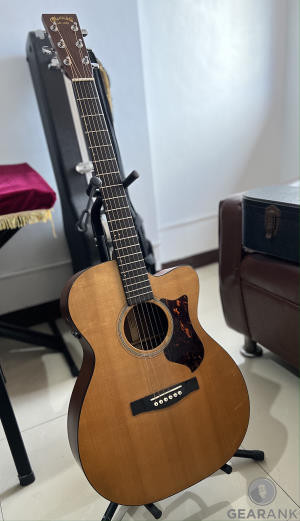 All-solid wood acoustic
All-solid wood acoustic
Laminated wood consists of thin sheets of wood glued and pressed together, while solid wood is a single piece cut directly from a tree. Solid wood resonates more freely than laminate due to its natural structure.
This difference in resonance results in solid wood guitars having a fuller, richer tone compared to laminate guitars. However, laminate wood is less expensive and widely used in budget-friendly acoustic guitars.
This distinction explains the tonal differences between laminate guitars, solid top guitars (laminate back and sides, solid top), and all-solid wood guitars. The greater the use of solid wood, the more resonant the guitar body becomes. The guitar top is the most critical component influencing tone, while the back and sides play a supporting role.
One advantage of laminate wood is its greater resistance to temperature and humidity changes, making it suitable for beginners or those who don’t prioritize meticulous guitar care.
For a more in-depth exploration of tonewoods and other buying considerations, consult our guide on Things To Consider When Buying An Acoustic Guitar.
Conclusion: Choosing Your Acoustic Guitar
We hope this comprehensive overview has clarified the diverse world of acoustic guitars. With numerous kinds of acoustic guitars available, understanding their differences can take time. Feel free to revisit this guide and re-read sections to solidify your understanding.
For any further questions or insights, please share them in the comments section below.
About the Author and Contributors
Original Author: Mason Hoberg
Update Contributor: Alexander Briones
Editor: Richard Guarnuccio
Related Articles:
The Best Beginner Acoustic Guitars
Things To Consider When Buying An Acoustic Guitar
The Highest Rated Acoustic Guitar Brands
The Best Classical & Nylon String Guitars – $99 to $1000
The Best Acoustic Guitar Strings – 6 String Sets
The Best Microphones for Recording Acoustic Guitar
The Best Acoustic Guitar Preamps
[

